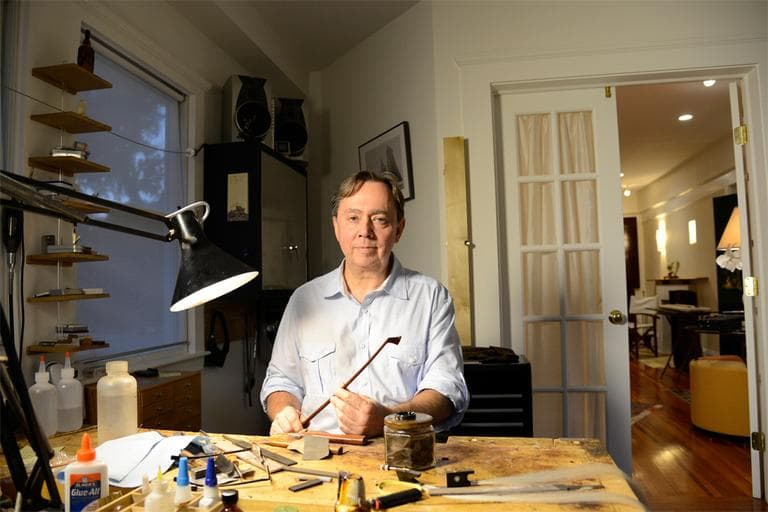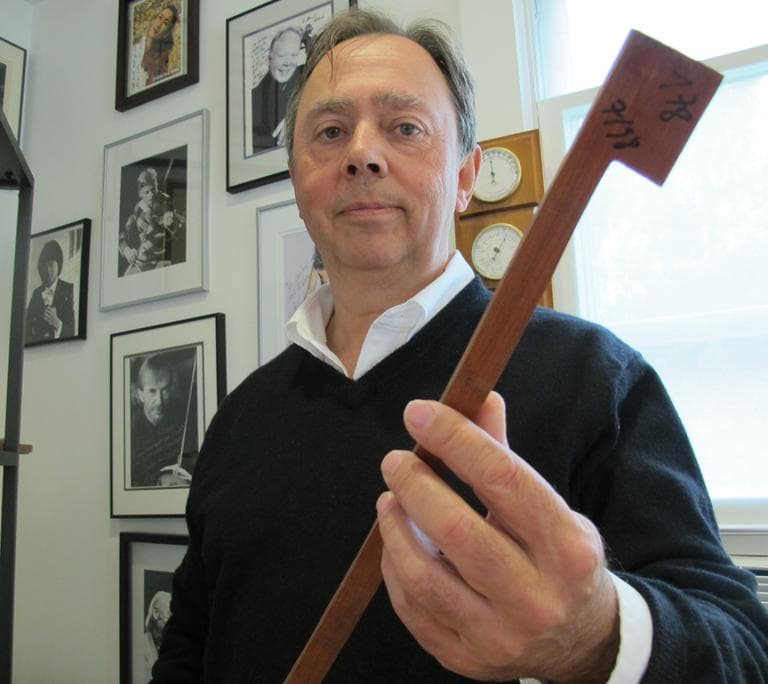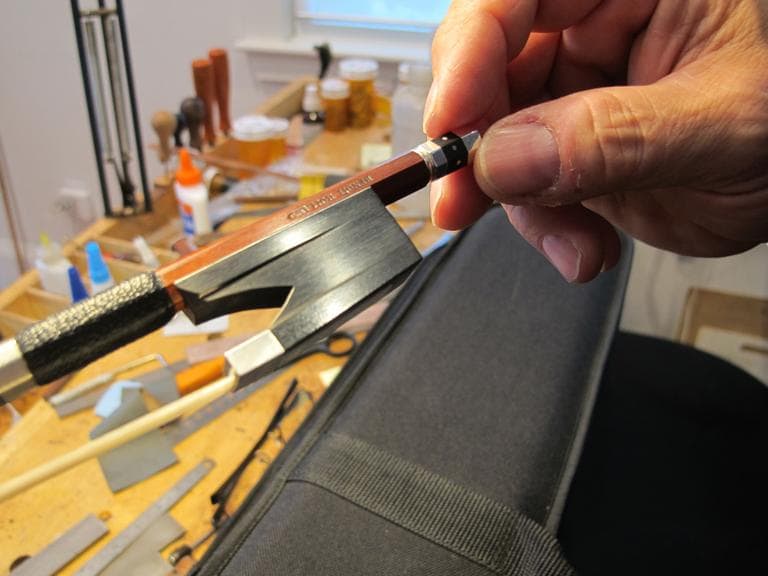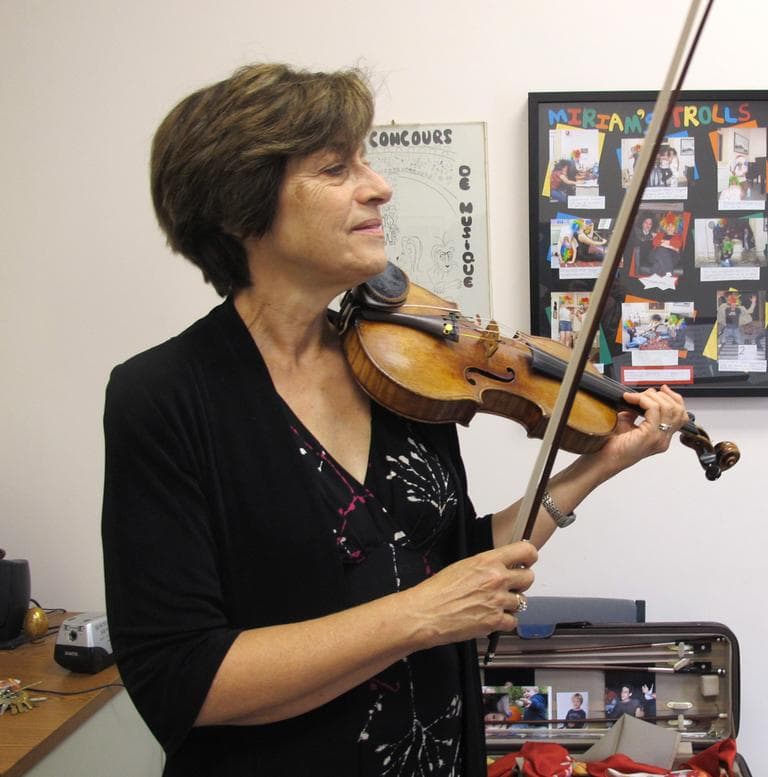Advertisement
The Man Behind A Thousand Bows Gets A 'Genius Grant'
Resume
This week, the John D. and Catherine T. MacArthur Foundation handed out 23 of its annual “genius grants." Four went to Boston-area recipients — a neuroscientist, an economist, a novelist and a Watertown-based bow maker. We visited Benoit Rolland in his home bow-making studio.
'It Has To Behave Like A Muscle'
In the fine instrument world the violin reigns supreme as the star of the strings, capable of fetching millions of dollars at auction. But what about the bow?
"A violin with no bow is not a violin, that’s clear," Rolland said.

Over the past 40 years, Rolland has made more than 1,400 bows for violins, violas and cellos. They’re used by some of the world’s best musicians. A few of their photos are up on the walls in the 58-year-old’s quiet studio. It’s like a who’s who of string players: Yehudi Menuhin, Stephane Grappelli, Mstislav Rostropovich.
"I could say the bow is extremely important for a musician because it has to convey the personality, the musicality, the emotions of the musician through it," Rolland said. "And it's something that has to behave like a muscle."
That said, Rolland admits the bow hasn’t always gotten the recognition it deserves. And that might be why he was skeptical when he received one of the most famous phone calls a creative person could receive.
In fact, Rolland assumed the person on the other end was trying to sell him something.
"So I asked him to repeat the name of the company and he told me, 'MacArthur Foundation, do you know it?' " Rolland recalled. "Yes! Of course I do. And I asked him, 'Are you serious?' He had to convince me that it was true."
'It Was Like A Jewel'

Rolland has now been recognized as both a traditional artist and an innovator. He pioneered the design of synthetic bows made of carbon fiber. His journey as a bow maker began in Paris, where his grandmother was a famous concert pianist. She taught him how to play her instrument at age 4. At age 9, Rolland fell in love with the violin. He graduated from the conservatories of Paris and Versailles and was on track to become a professional musician, but then he encountered a spectacular bow that altered the course of his life.
"So this bow was so beautiful, fitted with gold, 18 karats, and magnificent mother of pearl and magnificent wood," Rolland said. "It was like a jewel. So at this very moment I understood this was what I wanted to do."
He went on to study the historic French method of bow making and has been doing this ever since. He selects the wood from his large stash of rare, Brazilian Pernambuco. Each piece emits a unique sound.
Then there’s the 100 to 150 Mongolian horse hairs that become the ribbon. And "the frog" — which is a piece that adjusts tension. But Rolland says the most important variables are the musicians themselves. He interviews them, watches them perform, and listens closely to their music.
'The Bow Is Just As Important'

Miriam Fried, a violinist and teacher at the New England Conservatory, is one of the many musicians who wrote letters to the MacArthur Foundation endorsing Rolland’s nomination. She has three of his bows.
"What it is that he really understands what the bow does, how it does it, and what you want a bow to do for you," Fried said. "And he can make one for you that can accommodate your particular needs, and I think very few bow makers are like that."
Elita Kang, the assistant concert master of the Boston Symphony Orchestra, says a significant number of BSO musicians, including herself, use bows made by Rolland.
"A lot of people, even some instrumentalists, in our younger years we believe that the violin is of paramount importance and the bow is just a tool," Kang said. "But the bow is just as important as the violin because that is our breath, that's how we draw the sound out of the instrument, so without a fine bow that's responsive and flexible and finely made we can't express ourselves fully."
As a former violinist, Rolland understands musicians’ connection to all parts of their instruments. His years of bow making have stiffened his fingers, though, making it difficult for him to play. But Rolland says he still gets pleasure watching and listening to musicians using his bows on stage.
"Because I see this person playing [such] intimate things, the music, with something I brought in his hands, so it's marvelous," Rolland said.
And Rolland says the grant stipend of $500,000 will enable him not only to improve his art, but to pursue four new innovations he has in mind.
This segment aired on October 3, 2012.
